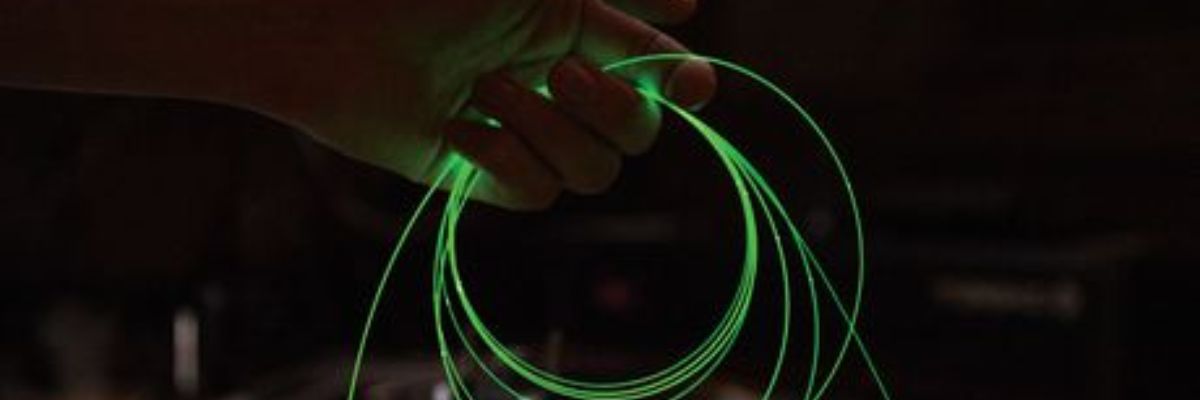
Optical fiber research in Czechia started 40 years ago
02. 04. 2019
Optical fiber: originally an underestimated invention which later completely changed the world of telecommunications technologies. In former Czechoslovakia, its research started in 1979 in laboratories of the Academy of Sciences. Today, the Institute of Photonics and electronics of the CAS is among the top laboratories capable of preparing special optical fibers for high-power fiber lasers. This is one of the reasons why scientists will meet this April in Prague at the SPIE Optics + Optoelectronics symposium.
The principle of light propagation in optical fibers is surprisingly simple – it basically utilises the phenomenon of total internal reflection on the boundary of the core and the coating of the fiber. Therefore, optical fibers are widely used in communications, replacing metal conductors, because signals in optical fibers are carried with less loss. At the same time, the fibers are immune to electromagnetic interference.
At the dawn of transfer of scientific knowledge into international practice was a scientist of Czech origin, Erich Spitz, who emigrated from Czechoslovakia to France in the 1950s. There he led a laboratory dealing with research of optical fibers for telecommunications in the beginning of 1960s. “Later, Erich Spitz also conducted the first successful attempt at image transfer through a single multi-mode optical fiber,” says Jiří Homola, director of the Institute of Photonics and Electronics of the CAS, regarding the mark of the Czech science on the worldwide engineering.
Transition between a glass preform and an optical fiber
Erich Spitz himself will be an important guest of the Optics + Optoelectrics symposium, held by the international society for optics and photonics SPIE from April 1 till April 4 in Prague.
The future belongs to fiber lasers
The so-called fiber lasers are now finding more and more uses in industry. They have a very high electro-optical efficiency (as much as circa 50 %), high output power and high-quality beam which can be focused over large distances. “Their use in the area of security, such as in protection against drones or improvised explosives, is also currently investigated,” says Pavel Honzátko, a team leader of Fiber Lasers and Nonlinear Optics at the Institute of Photonics and Electronics of the CAS, praising the unique properties of fiber lasers. “Thanks to the fact that the fibers are connected with welds, fiber lasers show a high resilience. What’s more, they require virtually no maintenance,” emphasises Pavel Honzátko.

Waveguide principle of light
The special optical fibers and fiber devices from the Institute of Photonics and Electronics are used in many other research institutes both in the Czech Republic and other countries, as well as in industry.
The title photo shows an optical fiber
Prepared by: Petra Palečková, Institute of Photonics and Electronics of the CAS, in cooperation with Markéta Růžičková, Department of Media Communication of the Head Office of the CAS
Photo: Institute of Photonics and Electronics of the CAS
Read also
- ERC Consolidator Grant heads to the CAS for “wildlife on the move” project
- A little-known chapter of history: Czechoslovaks who fought in the Wehrmacht
- Twenty years of EURAXESS: Supporting researchers in motion
- Researching scent: Cleopatra’s legacy, Egyptian rituals, and ancient heritage
- The secret of termites: Long-lived social insects that live in advanced colonies
- Two ERC Synergy Grants awarded to the Czech Academy of Sciences
- Nine CAS researchers received the 2025 Praemium Academiae and Lumina Quaeruntur
- Step inside the world of research: Week of the Czech Academy of Sciences 2025
- A / Magazine: Bugs, the rusting human body, and beauties from the kingdom of ice
- PHOTO STORY: The invasive black bullhead catfish threatens Czech fishponds
The Czech Academy of Sciences (the CAS)
The mission of the CAS
The primary mission of the CAS is to conduct research in a broad spectrum of natural, technical and social sciences as well as humanities. This research aims to advance progress of scientific knowledge at the international level, considering, however, the specific needs of the Czech society and the national culture.
President of the CAS
Prof. Eva Zažímalová has started her second term of office in May 2021. She is a respected scientist, and a Professor of Plant Anatomy and Physiology.
She is also a part of GCSA of the EU.